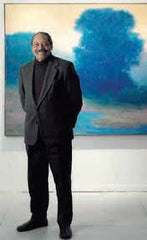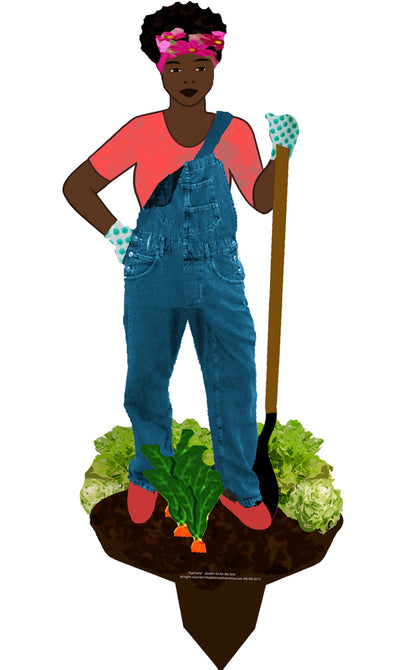Mayhew, Richard, (Spring Mood series #7)
Mayhew, Richard, (Spring Mood series #7)
"Spring Mood series #7" by Richard Mayhew
12 x 8 inches watercolor painting on paper, (2016) -- framed
 Richard Mayhew was born in 1924 in Amityville, New York. He was born to Alvin and Lillian Mayhew, whose common African American and Native American descent would become important to Richard. At a young age, his grandmother, Sarah Steele Mayhew, instilled in him a deep reverence for nature as she taught him “the nature lore, ways and attitudes” of American Indians. His appreciation for art also started at a young age, when each summer artists from New York City would come to Amityville to capture and paint the seashore. Mayhew was fascinated by these artists and started experimenting on his own using his father’s paints and brushes. When he was 14, one of the artists asked to see what he could do, which opened the door for Mayhew to join them regularly to paint and receive encouragement. In his late teens, Mayhew would frequently visit the Metropolitan Museum of Art, where he studied Rembrandt and many American landscapists. He continued to learn about painting in an English magazine, Apollo, and, by the time he turned 17, he decided he wanted to be an artist.
Richard Mayhew was born in 1924 in Amityville, New York. He was born to Alvin and Lillian Mayhew, whose common African American and Native American descent would become important to Richard. At a young age, his grandmother, Sarah Steele Mayhew, instilled in him a deep reverence for nature as she taught him “the nature lore, ways and attitudes” of American Indians. His appreciation for art also started at a young age, when each summer artists from New York City would come to Amityville to capture and paint the seashore. Mayhew was fascinated by these artists and started experimenting on his own using his father’s paints and brushes. When he was 14, one of the artists asked to see what he could do, which opened the door for Mayhew to join them regularly to paint and receive encouragement. In his late teens, Mayhew would frequently visit the Metropolitan Museum of Art, where he studied Rembrandt and many American landscapists. He continued to learn about painting in an English magazine, Apollo, and, by the time he turned 17, he decided he wanted to be an artist.
In 1945, Mayhew moved to New York City and became a freelance medical illustrator and was mentored by James Wilson Peale. In 1951, he started taking classes at the Brooklyn Museum of Art. He studied under many teachers, such as Reuben Tam, Edwin Dickson, Victor Kandel, Gregorio Prestopino, Hans Hofmann and Max Beckman. During this time, Mayhew also took classes at the Pratt Institute and obtained a degree in art history from Columbia University. To survive as an artist, Mayhew was an illustrator for children’s books and designed lamps and china ware. He also had jobs singing with jazz combos and performed in the theatre.
In 1955, Mayhew had his first solo exhibition at Brooklyn Museum and two years later his second solo exhibition at Morris Gallery in Greenwich Village. His early shows received high critical praise. The critics admired his use of light, color, and form, as they compared him to Claude Monet and Winslow Homer. Sidney Tillum of Arts magazine, said Mayhew’s landscapes are “poised in their nostalgia are painted with…a sense of period, American style, with out being able to place it.” Mayhew has a talent to suggest his landscapes in a spiritual and mystical way, rather than depicting specific places.
In 1959, Mayhew received the John Hay Whitney Fellowship, which enabled him to attend the Academia in Florence, Italy. After spending one year there, his teachers encouraged him to broaden his horizons and increase his influences. “They told me that being away from my own environment would enable me to be more objective about who I was and where I was.” Upon receiving The Ford Foundation Grant, Mayhew traveled to Europe to visit Museums and study a variety of artist’s works. Through this experience, Mayhew acquired a sense of how artists interpret their environments and lifestyles at that time. He studied color, composition, and design, and found his identity as an artist.
In 1962, Mayhew returned to the States and started teaching courses at the Brooklyn Museum. During this time, the civil rights movement had begun its political challenge against racism and discriminatory policies, which left Mayhew feeling unsure of his own identity. So Mayhew and fellow African-American artists formed the Spiral Group. Together the group challenged and stimulated one another’s thinking through debates over how their artwork assisted the struggle for civil rights. Mayhew was enriched as an artist through this group, as he learned how to identify with other African-American artists and how their identity influenced their art.
During this time, Mayhew began identifying his feelings through the use of color. He used a new technique to apply color, where he applied opaque paint over paint that allows underlying colors to show through. This resulted in different intensities of color that changed in different lighting. This new style was described by Bearden and Henderson, when they said it “adds new luster to the American vision in this field, with paintings that have poetic serenity and illusive quality of light. In Arts magazine, Mayhew’s landscapes were described as “incredible color abstractions…stunning and unexpected.”
From 1963 to 1977, Mayhew taught at many schools, including the Pratt Institute, the Art Students League, Smith College, Hunter College, San Jose State University, and Sonoma State University. During this time, Mayhew received the National Institute of Arts and Letters grant in 1965 to further his creative work of outstanding merit. He also received the National Academy of Design Merit Award in 1977, for his distinguished paintings.
From 1977 to 1991, Mayhew was a professor in the visual arts at the Pennsylvania State University. During his time at Penn State, he took a sabbatical to study the American landscape. His time in Mexico, Arizona, and California stimulated and challenged his imagination, since there was always new lighting, new space and new inspirations for his paintings. When returning he created 20 paintings in three months, making it the “most artistically prolific period of his life.” Working only from memory, he relives his experiences to recreate the landscapes on canvas. According to Mayhew, his “art is based on a feeling…of music and mood and sensitivity and the audio responses of sound and space. I want the essence of the inner soul to be on the canvas.”
After retiring from Pennsylvania State University, Mayhew returned to Santa Cruz, California, where he now lives. Santa Cruz’s terrain reminds him of his home in Amityville and stimulates his imagination to continue to create. Mayhew’s style today is best described as neo-American impressionism.
- Secure payments
- In stock, ready to ship
- Inventory on the way




































